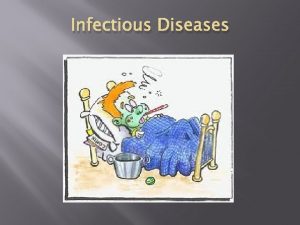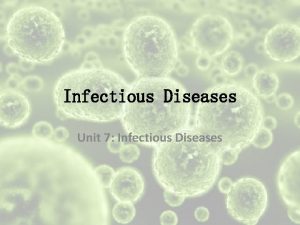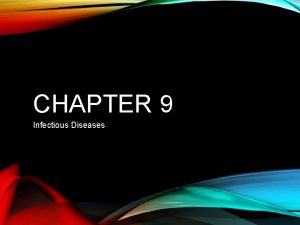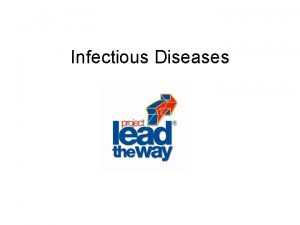Infectious diseases 5 th Semester Classes on Infectious











- Slides: 11

Infectious diseases 5 th Semester Classes on Infectious Diseases, 8 -9 AM, Thursdays (LT-4) Topics Date Approach to Infectious Diseases and their prevention 04/Jul/17 Community-Acquired Infections 27/ Jul /17 Health Care–Associated Infections 03/ Aug/17 Gram-Positive Bacteria (part-1) 10/ Aug/17 Gram-Positive Bacteria (part-2) 17/Aug/17 Gram-Negative Bacteria (part-1) 24/ Aug /17 Class bunked due to strike 31/ Aug /17 Gram-Negative Bacteria (part-2) 07/ Sep/17 Spirochetal Diseases 14/Sep/17 Diseases Caused by Atypical Bacterial Infections 21/Sep/17 Infections Due to DNA Viruses 28/Sep/17 Infections Due to RNA Viruses 05/Oct/17 Human Immunodeficiency Virus Disease: AIDS and Related Disorders 12/Oct/17 Fungal Infections 26/Oct/2017 Dr. P. K. Panda, Protozoal Infections 02/Nov/2017 Asst. Professor Helminthic Infections 09/Nov/2017 Department of Medicine AIIMS, Rishikesh

Spirochaetales Leptospira species, which cause leptospirosis Borrelia species, which cause relapsing fever and Lyme Brachyspira species, which cause intestinal infections; and Treponema species, which cause the diseases treponematoses The Treponema species include T. pallidum subspecies pallidum, which causes venereal syphilis; T. pallidum subspecies pertenue, which causes yaws; T. pallidum subspecies endemicum, which causes endemic syphilis; and T. carateum, which causes pinta T. pallidum cannot be cultured in vitro and only known natural host is the human Jarisch- Herxheimer reaction is always a possibility in all spirochetes

Nearly all cases of syphilis are acquired by sexual contact with infectious lesions (i. e. , the chancre, mucous patch, skin rash, or condylomata lata) Others: personal contact, infection in utero, blood transfusion, and organ transplantation IP – average 21 days Rapidly penetrates intact mucous membranes or abrasions in skin and, within a few hours, enters the lymphatics and blood to produce systemic infection Identification and examination of sexual contacts are most important for patients with syphilis of <1 year’s duration The clinical appearance depends on the number of treponemes inoculated and on the immunologic status of the patient

Primary Syphilis - primary chancre Secondary Syphilis - parenchymal, constitutional, and mucocutaneous manifestations Tertiary Syphilis – gumma (a usually benign granulomatous lesion); cardiovascular syphilis (usually ascending aorta and resulting in aneurysm); and neurosyphilis (asymptomatic, meningeal, meningovascular, and parenchymatous (tabes dorsalis and paresis) syphilis) Latent Syphilis - Positive serologic tests for syphilis, together with a normal CSF examination and the absence of clinical manifestations Congenital Syphilis - fetal damage generally does not occur until after the fourth month of gestation; most common clinical problem is the healthy-appearing baby born to a mother with a positive serologic test Routine serologic testing in early Screening or diagnosis (RPR or VDRL) Quantitative measurement of antibody to assess clinical syphilis activity or to monitor response to therapy (RPR or VDRL) Confirmation of a syphilis diagnosis in a patient with a reactive RPR or VDRL test (FTA-ABS, TPPA, EIA/CIA) Persons with newly diagnosed HIV infection should be tested for syphilis; conversely, all patients with newly diagnosed syphilis should be tested for HIV infection


An infant should be treated at birth • if the treatment status of the seropositive mother is unknown; • if the mother has received inadequate or nonpenicillin therapy; • if the mother received penicillin therapy in the third trimester; or • if the infant may be difficult to follow


Leptospirosis Recent outbreaks on virtually all continents (mainly in the tropics and subtropics) By pathogenic species, L. interrogans designated as L. interrogans sensu lato Underappreciated problem with a broad spectrum of clinical manifestations, varying from asymptomatic infection to fulminant, fatal disease Rodents, especially rats, are the most important reservoir Transmission may follow direct contact with urine, blood, or tissue from an infected animal or, more commonly, exposure to environmental contamination through cuts, abraded skin, or mucous membranes IP - 1 to 30 days Leptospiremic phase – evade complement-mediated killing by binding factor H Immune phase - bacteria persist in various organs


Mild Leptospirosis - usually presents as a flu-like illness, with fever, conjunctival suffusion, pharyngeal injection, muscle tenderness, lymphadenopathy, rash, meningismus, hepatomegaly, and splenomegaly Severe Leptospirosis - Weil's syndrome, encompasses the triad of hemorrhage, jaundice, and acute kidney injury; Other syndromes include (necrotizing) pancreatitis, cholecystitis, rhabdomyolysis, and neurologic manifestations including aseptic meningitis Clinical diagnosis should be based on an appropriate exposure history combined with any of the protean manifestations Definitive diagnosis is based on isolation of the organism, polymerase chain reaction (PCR), or seroconversion or a rise in antibody titer (by MAT/ELISA) Nonoliguric hypokalemic renal insufficiency is characteristic of early leptospirosis

Thank you Next Class Diseases Caused by Atypical Bacterial Infections 21/ Sep/17
 Emerging infectious diseases
Emerging infectious diseases Icd 10 morbus hansen
Icd 10 morbus hansen à classe e subclasse
à classe e subclasse Pre ap classes vs regular classes
Pre ap classes vs regular classes Stages of infectious disease
Stages of infectious disease Infectious stunting syndrome
Infectious stunting syndrome Infectious canine hepatitis in dogs
Infectious canine hepatitis in dogs Infectious disease quality controls
Infectious disease quality controls Hennepin county infectious disease manual
Hennepin county infectious disease manual Infectious canine hepatitis in dogs
Infectious canine hepatitis in dogs Infectious nucleic acid
Infectious nucleic acid Stages of infection
Stages of infection





















